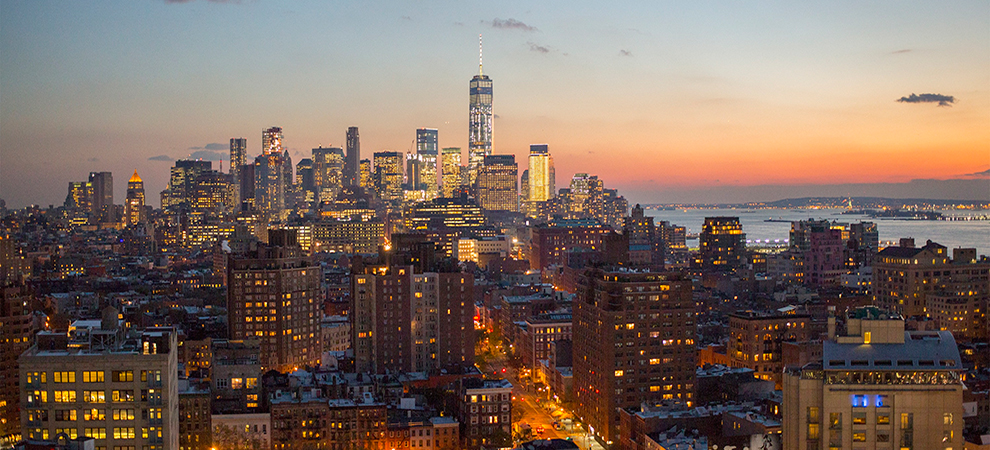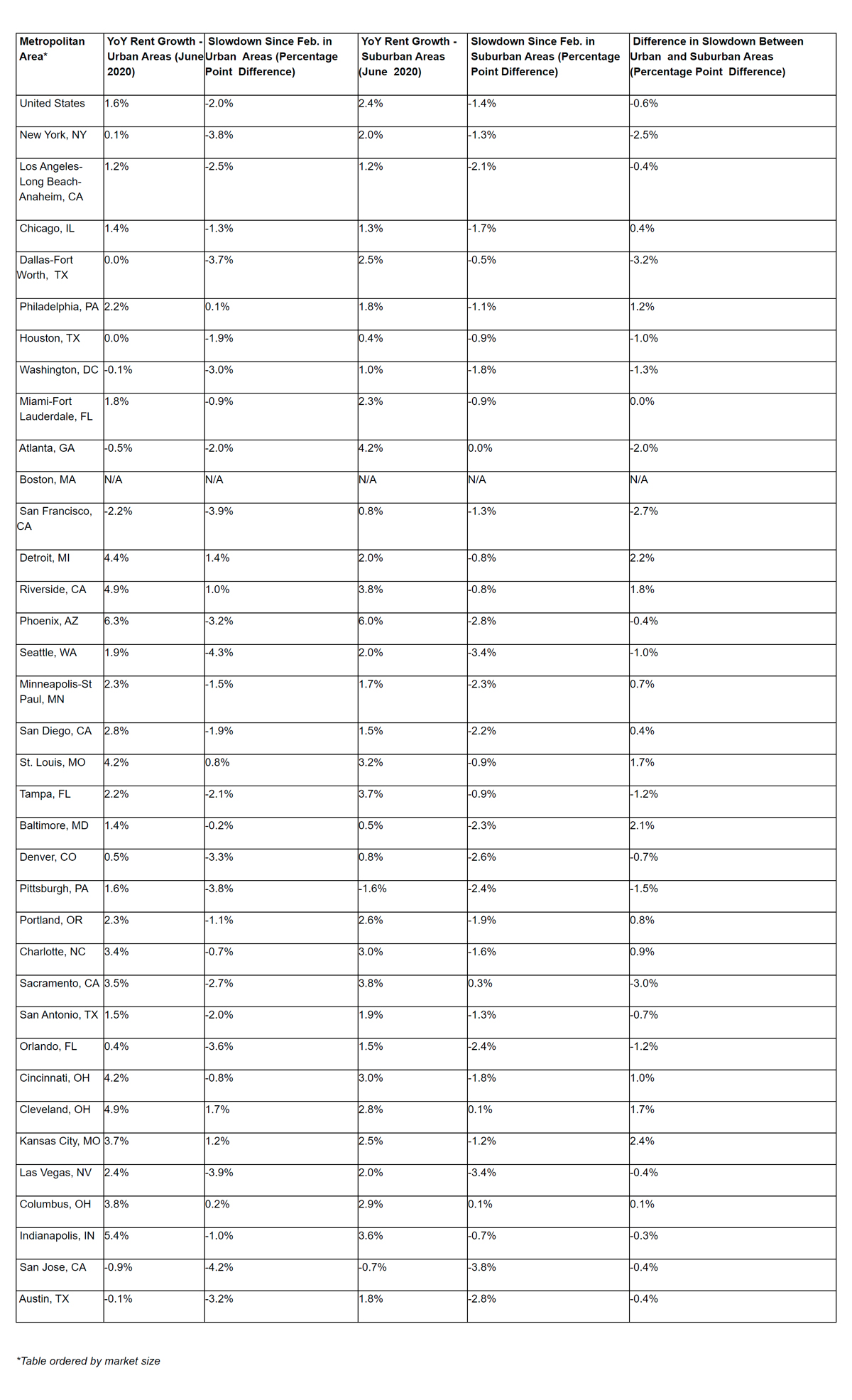The WPJ
THE WORLD PROPERTY JOURNALReal Estate Facts Not Fiction
Residential Real Estate News

Urban Rent Slowdown From COVID Signals Consumers New Interest in Suburbs
Residential News » New York City Edition | By Michael Gerrity | August 5, 2020 9:00 AM ET
Based on new research by Zillow, residential rent growth in the U.S. hit the brakes this spring due to the Coronavirus outbreak. In addition, rent prices in urban areas have slowed more than those in suburban areas, signaling that renters' preferred location in a COVID-19 world is now tilting toward the suburbs.
Rents were chugging along at a stable pace into the early 2020, until the Coronavirus outbreak started in the U.S. Since then, and coupled with a significant spike in unemployment starting in Q2, residential renters more severely than homeowners, and millions have moved back in with parents or grandparents, impacting demand for rentals. That's caused the rate of rent growth to slow from February to June 2020.
During that period, rent price growth has slowed more in urban ZIP codes than in the suburbs -- annual rent growth has slowed two percentage points in urban areas, compared to 1.4 percentage points in suburban areas. That is a subtle split, but it goes against the trend seen just before COVID-19 hit the U.S., indicating the shift was influenced by the pandemic. Urban and suburban renters alike are missing rent payments or have moved home during the pandemic to a similar degree, but typically less expensive suburban rentals may now be more appealing for those who no longer need to commute or are temporarily unable to enjoy some of the amenities of urban living.
Renters usually have more flexibility than homeowners given their relatively short lease terms, and rent prices are often quicker to move as a result. Zillow search traffic data does not yet show home shoppers are more interested in suburban homes than in past years, and both areas are seeing similar home-value growth, time on market, sales above list price and rate of newly pending sales. Survey results, however, indicate working remotely is causing many to reconsider their options. If this early shift in the rental market is indicative of a more widespread change in preferences, similar changes to the for-sale market could follow, but the economic impact on renters may be playing a larger role.
"It's important to separate how much of the trend we are seeing comes from shifting tastes as opposed to the economic reality that renters face," says Zillow economist Joshua Clark. "It may be tempting to conclude that urban renters who have been cooped up without outdoor space and unable to visit their favorite local bar are ready to commit to suburban life, and that is likely true for many. But that narrative ignores the job loss that has hit renters, who are disproportionately employed in the industries most affected, and has likely played a bigger role in recent moves."
This split between urban and suburban rent growth was present in more than half of large U.S. metros studied. The biggest gaps were in Dallas-Fort Worth, Sacramento, San Francisco and the greater New York metro.
Not all markets are following this pattern. Urban rent growth has been stronger than suburban growth in some metros, and that difference is biggest in Kansas City, Detroit, Baltimore, Riverside and St. Louis. Rents in both urban and suburban areas of Kansas City are accelerating, but urban rents are to a greater degree. Baltimore rent growth was softening before the pandemic, and has continued on that trajectory.
Sign Up Free | The WPJ Weekly Newsletter
Relevant real estate news.
Actionable market intelligence.
Right to your inbox every week.
Real Estate Listings Showcase
Related News Stories
Residential Real Estate Headlines
- U.S. New-Home Sales Surge in August as Mortgage Rates Ease
- Despite Increased Foreign Buyer Activity, Miami Residential Sales Dip 11 Percent in August
- California Home Sales Enjoy Modest Uptick as Mortgage Rates Ease
- U.S. Home-Flipping Profits Sink to Lowest Level Since 2008 Financial Crisis as Costs Climb
- Why the World's Rich Are Flocking to Europe in 2025
- Federal Reserve Delivers First Rate Cut of 2025 as Mortgage Relief Proves Limited
- Homebuilder Sentiment Holds Steady in U.S. as Rate-Cut Bets Lift Outlook
- U.S. Mortgage Rates Experience Sharpest Weekly Drop in Over a Year
- U.S. Foreclosures Rise for Sixth Straight Month as Affordability Pressures Mount
- Black U.S. Homeownership Rate Falls to Two-Year Low as Job Losses Mount
- Las Vegas Home Prices Flatten as Listings Surge, Sales Slow
- Cooling Miami Housing Market Sees 16 Percent Annual Sales Drop in July
- U.S. Mortgage Delinquencies Uptick in June Amid Regional Pressures
- California, Florida Top U.S. Housing Markets Most at Risk of Downturn
- 30-Year Mortgage Drops to 6.56 Percent in Late August, Lowest Since October 2024
- Investors Maintain Elevated Role in U.S. Housing Market Despite Slight Pullback
- Pending Home Sales Show Mixed Signals as U.S. Buyers Remain Cautious
- Canadian Home Sales Extend Recovery in July
- U.S. Home Sales Rise in July as Buyers Gain More Bargaining Power
- Zombie Foreclosures Edge Up Across U.S.
- 2.6 Million Homes at Wildfire Risk Across 14 Western States in 2025
- One in Five Americans Willing to Trade Personal Safety for Home Affordability
- U.S. Home Price Growth Slows as Affordability Pressures Mount in 2025
- U.S. Mortgage Rates Dip to Four Month Low in Early August
- U.S. Mortgage Applications Rise in Late July, Breaking Four-Week Slump
- Hong Kong's Housing Market Stuck in Stalemate as Bulls and Bears Face Off
- U.S. Condo Market Struggles in 2025
- U.S. Pending Home Sales Remain Sluggish in June
- Los Angeles Area Wildfires Destroyed Nearly $52 Billion in Homes Last January
- Greater Palm Beach Area Residential Sales Slip in June Amid Growing Inventory
- Economic Resilience Lifts U.S. Housing Outlook Going Forward
- New Home Sales Stagnate as Affordability Struggles Continue in America
- U.S. Housing Market Slips in June as Prices Hit New Highs
- Florida, California Continue to Reign Supreme as America's Ultraluxury Housing Markets
- Caribbean Housing Market Evolves into Global Second-Home Hotspot
- U.S. Home Sales See Highest June Cancellation Rate on Record
- Orlando Housing Market Cools in June as Listings Slide, Sales Slow
- Private Credit Surges in 2025 as Real Estate Developers Bypass Banks
- U.S. Condo Market Suffers Sharpest Price Drops in Over a Decade as Buyers Retreat
- Rising Taxes, Insurance Costs Undermine the Stability of U.S. Homeownership
Reader Poll
Marketplace Links
This website uses cookies to improve user experience. By using our website you consent in accordance with our Cookie Policy. Read More








